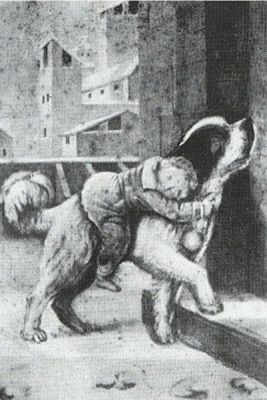|
Deep in the
Alps, and from very ancient times, is a path that leads from Turin,
Italy to Valais, Switzerland. Perpetually blanketed in snow seven to
eight feet deep, with drifts up to forty feet deep, this pass is
exceedingly dangerous and blighted with avalanches, but still, it was
well used by pilgrims, especially French
and German ones on their way to Rome.
Around A.D. 1050, an Italian
priest named Bernard -- a man who'd spent four decades spreading the
Gospel -- built a monastery there, with two hospices to aid
these poor, disressed
travelers. Relying on donations for sustenance, the Augustinan monks
who run the hospices offer food, clothing, and shelter to travelers and
take care of the dead.
The monks also
began breeding dogs who'd be perfect for the sorts of mountain rescues
needed in the area. The breed that resulted -- now known as the St.
Bernard -- is an enormous dog with a low-hanging, heavy tail and a
white coat with red or brown brindle, and black around the face.
Their temperament is that of a "gentle giant" -- calm, sweet, and wonderful with
children. These beautiful animals are often
shown in pictures sporting little wooden kegs around their necks with
which to bring brandy to the stranded in order to revive them.
In 1823,
Thomas Byerley wrote in "The Percy Anecdotes," of one particularly
heroic St. Bernard named Barry, a dog who's become known to us in
German as "Menschenretter"
(People-Rescuer), and who was born in 1800 and died in 1814:
The breed of
dogs kept by the monks to assist them ... has been long celebrated for
its sagacity and fidelity. All the oldest and most tried of them were
lately buried, along with some unfortunate travellers, under avalanche;
but three or four hopeful puppies were left at home in the convent, and
still survive. The most celebrated of those who are no more, was a dog
called Barry. This animal served the hospital for the space of twelve
years, during which time he saved the lives of forty individuals. His
zeal was indefatigable. Whenever the mountain was enveloped in fogs and
snow, he set out in search of lost travellers. He was accustomed to run
barking until he lost breath, and would frequently venture on the most
perilous places. When he found his strength was insufficient to draw
from the snow a traveller benumbed with cold, he would run back to the
hospital in search of the monks….
When old age deprived him of strength, the Prior of the Convent
pensioned him at Berney, by way of reward. After his death, his hide
was stuffed and deposited in the museum of that town. The little phial,
in which he carried a reviving liquor for the distressed travellers
whom he found among the mountains, is still suspended from his neck.

A monument to
Barry stands in the Cimetière des
Chiens near Paris, and his body, preserved by taxidermy, can be
seen at the Natural History Museum of Bern.
So the next time you see a St. Bernard, think of Barry. Better yet,
think of St. Bernard, for whom his kind is named. Even better yet,
think of the great God Who created dogs in the first place and gave
them to us as friends.
Note:
St. Bernard of Menthon is also known as St. Bernard of Montjoux.
|
|

